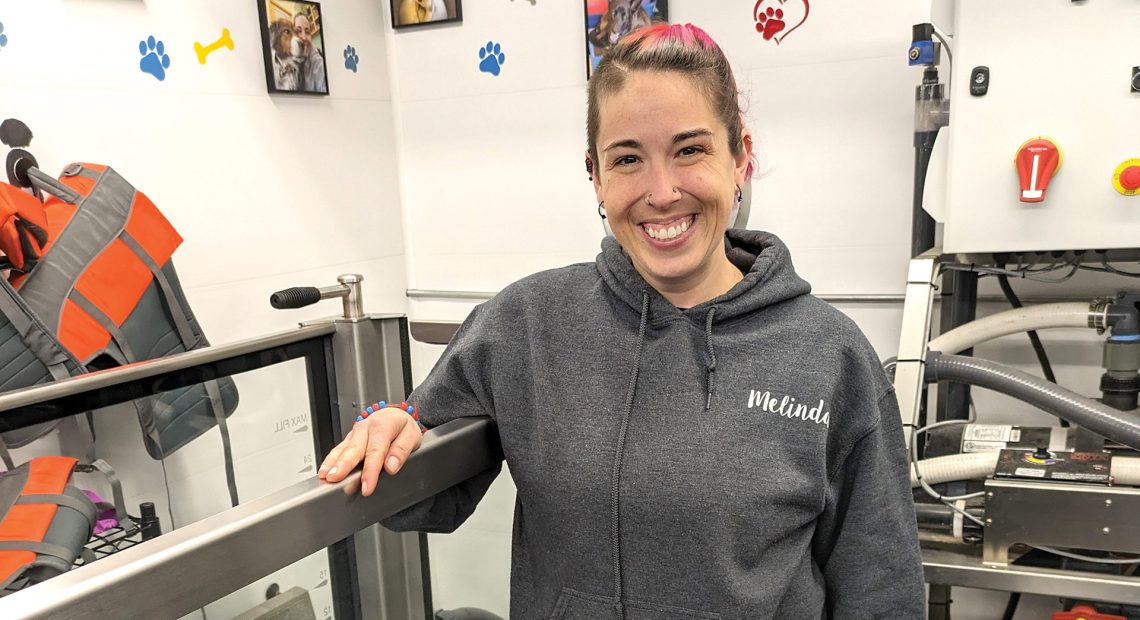
It’s About Quality of Life at Power Paws Canine Rehabilitation
Gone to the Dogs

Melinda Harris has always wanted to work with animals.
“That was never a question in my mind,” she said. “My grandfather had dogs and birds and everything else. My mom always joked that I got it from him because he was the animal lover. I had dogs and cats growing up, and as soon as I was in high school and I had the option of taking physics or doing an internship at a veterinary hospital, well, guess which one I picked?”
She’s had a winding path in animal care since then, all of which led her to the culmination of a dream: opening Power Paws Canine Rehabilitation in Granby last spring.
“I was booked up for a month solid before I even opened the doors,” she told BusinessWest. “And I have never not been booked less than two or three weeks out since then. So it’s been really busy.”
Harris’s canine patients have ranged in age from 6 months to 18 years, and they’re brought in for a variety of reasons.
“It’s definitely a mix. There are different kinds of knee surgeries out there, and I’ll see dogs that have had any one of them. I have dogs that come in that are trying to avoid knee surgery, so we’re trying to build up and strengthen that leg so they don’t need to go forward with surgery. I’ve had hip surgeries, and I’ve had geriatric dogs that come in for conditioning and to keep their strength up. I’ve had neurologic cases like strokes.
“And I’ve had a few agility dogs and working dogs that want to keep their strength up so that they can compete at a high level,” she continued. “I have a couple of FEMA dogs, search and rescue, that come in, and they’re very strong. So they go in the underwater treadmill and run for 20 minutes, and it helps keep them strong.”
“I was booked up for a month solid before I even opened the doors. And I have never not been booked less than two or three weeks out since then. So it’s been really busy.”
Harris offers a series of treatment packages targeted to each patient’s needs, starting with an in-depth consultation and plan, which may include a combination of exercise equipment, an underwater treadmill, and laser therapy.
“Almost every dog, unless they’re coming in for general conditioning, will get a laser treatment on whatever is bothering them,” she said. “And then we’ll do different exercises depending on what the condition requires; they’re beneficial for so many different things. And I would say 90% of the clients will also use the underwater treadmill; that has been fantastic for a lot of dogs.”
The device, which offers different levels of resistance through both the moving tread and the water, isn’t exactly the fun part of the session.
“People ask me, ‘do you have a hard time getting them to go in there? Do they fight you?’ I mean, some of them get a little upset when they first go in. They might try to climb out or splash, but I haven’t had a dog yet that I haven’t been able to train to accept the treadmill.”
Part of Harris’s training and expertise, obviously, has to do with how she handles the dogs.
“Generally speaking, my rule of thumb is, I don’t force a dog to do anything,” she explained. “So if a dog doesn’t want to do something, we’ll find a different way to do it, or we’ll skip that altogether. So maybe the first or second visit, we don’t go in the treadmill. Or maybe we throw some cookies in, let them go in and sniff it out, and when they seem more comfortable with me, then we’ll go in the treadmill and see what the dog is willing to do.

Melinda Harris stands beside the water treadmill at Power Paws.
“But I don’t muzzle dogs, and I don’t force them to do things, because we have to have a working relationship for weeks and months, and if they’re afraid of me, it’s not going to work,” she went on. “So everything is very treat-based, play-based — and the dogs are absolutely looking forward to running in the door when they get here.”
Animal Attraction
It helps that Harris has loved animals all her life. After high school, she took a year off, working at a pet store and as a groomer — “I’ve always been working with animals, even if it’s not in the veterinary setting” — and then went back to school, earning a certification in veterinary science in 2003.
“I was a veterinary nurse for about six years, working at Southwick Animal Hospital,” she recalled. “The owner/doctor there had another doctor coming in and doing orthopedic surgeries, and she said, ‘why don’t you check out this class on rehab and see if you like it?’ So I said, ‘sure.’”
As it turned out, Harris loved the class and decided to seek certification in that specialty, so she enrolled a program at the University of Tennessee, which, beyond the classwork, involved a 200-hour internship, six case studies, practical work, and more, and in 2009, she became a certified canine rehabilitation practitioner.
Three years later, she took a job with Riverbend Animal Hospital in Hadley, working for Dr. David Thomson, one of the region’s foremost animal surgeons. Her initial role there was in wellness and as a technician, but a few months in, she began doing rehab work.
“He really let me do what I needed to do for rehab; I set all the programs up, I did all the post-op care, all that kind of stuff, and started making connections with local veterinarians, and they would start referring some of their patients over to me as well, outside of Dr. Thomson,” she said. “And after doing that for about six years or so, I thought, this is a really good business model.”
“Everything is very treat-based, play-based — and the dogs are absolutely looking forward to running in the door when they get here.”
She also knew there weren’t many full-service canine rehabilitation practices in the region, so she could fill a need by opening her own. But at first, she struggled to find the right location, one that offered her the space and amenities she needed at an affordable price.
“And right about this time last year, I was driving by, and this place was for lease. I thought, it’s a really good standalone building that could be perfect for rehab. So I called up the number on the sign, I got right in, and I fell in love with it instantly. I knew this was absolutely the space that I want to do rehab in.”
After a few months building it out with new walls and flooring, paint, and other renovations, Harris opened Power Paws on April 3, and she hasn’t regretted the move once. “It’s been a crazy year. After nine months, it’s just as successful as I thought it was going to be.”
The job is one of constant learning and evolution, too.
For example, “laser therapy used to be much different when I first went to school for it. It was much lower power, there wasn’t a lot of science behind it, and a lot of research since then has gone into what wavelengths and joules and energy are most effective for different things. And now I can just put in a condition, the size of the dog, the color of the dog, and it gives me exactly what I need, which is really helpful. So that’s definitely come a long way.”
In addition, she explained, shockwave treatments have long been helpful for tendon and ligament injuries, but the dogs had to be fully anesthetized because it was painful and very loud, so it wasn’t cost-effective for a lot of people. But now, mobile units are available that don’t require anesthesia. “Someday, I’ll get that here — I don’t have it quite yet — but that’s been a big change for sure.”
Beyond technology, Harris also attends continuing-education classes in rehab each year, while drawing on ideas from other sources as well.
“I’m always learning new exercises that I can do with dogs because there are so many smart people in the world that have put together videos and blogs, and every day, I’m just constantly learning — how can I make this dog better? What’s a different exercise I can do that would make a bigger difference for this dog? It’s a really great community out there where everybody shares information and collaborates, which is really nice.”
Pet Project
Not surprisingly, the most gratifying part of Harris’s job is seeing how happy the dogs are when they come in — and seeing them gradually grow stronger and healthier.
“I really love seeing them yanking their owners across the parking lot to come in because they want to come in and play, and I love seeing them get better, having them go from withdrawn and not engaging much with their owners, because they’re in pain, to figuring out what’s painful, treating that, and turning them into a dog the owners forgot they had. That’s really, really rewarding.”
The dog owners are often surprised at the effectiveness of properly targeted rehab, she added.
“Usually they’re pretty blown away after a few treatments. They’re like, ‘they’re so much better, and they’re doing this thing that they never did in a long time,’ or ‘they’re playing with toys again; they’re playing with the other dog.’ It’s great to hear the stories of how much happier their dog is.”
Harris still works one day a week at Riverbend, and appreciates how supportive Thomson has been in her reaching her goal of owning a business.
“He’s retiring soon, so it was a good time for me to transition out and do my own thing here,” she said. “I’m very grateful and very lucky to be here.”





